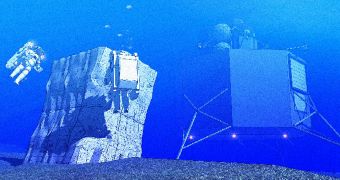One of the main directions of development for NASA today is the creation of a mission capable of taking people to near-Earth objects (NEO), the Moon or Mars. But technologies to do so are still under-researched, and this is why experts are recreating the surface of asteroids below the sea surface.
The ocean floor is the perfect location for simulating how the surface of an asteroid or other large space rock looks like. By using this environment, experts want to ensure that they develop the most suitable landing, docking and take-off methods.
When visiting NEO, the most important thing to consider is that potential spacecraft carrying out the missions would always operate in microgravity. This is different from when NASA went to the Moon, as Earth's natural satellite has nearly 1/6th the Earth's gravity.
The simulations are being carried out as part of the 15th expedition in the NASA Extreme Environment Mission Operations (NEEMO 15). The efforts will be conducted starting October 17, but engineers are already beginning to set the stage for this large-scale experiment.
These investigations will be carried out off the coast of Key Largo, in the Florida Keys, at the US National Oceanic and Atmospheric Administration's (NOAA) Aquarius Underwater Laboratory (AUL).
This location is placed about 19 meters (62 feet) under the surface of the Atlantic Ocean, and provides the perfect spot for such investigations. Datasets collected here will enable astronomers to develop technologies that would make exploring asteroids easier.
Preparations for the October investigation are carried out between May 9 to May 13. Also a part of the landscape that astronauts will survey later this years is a large wall, which engineers are lifting at the bottom of the sea, Space reports.
“The rock wall is going to be used to simulate the surface of an asteroid. For the engineering tests, it will be 16 by 12 feet. It's made of fiberglass panels,” explains NASA spokesperson Brandi Dean.
“They'll try out different anchoring methods on it – drilling into it or using metal plates to simulate magnetic anchoring,” she goes on to say. This is necessary because there would be no gravity whatsoever on asteroids, and explorers would need to stay in touch somehow.
“Even experts don't know what the surface of an asteroid is going to be like. There may be asteroids that we don't even know about yet that we'll be visiting. So we're figuring out the best way to do that,” explains Bill Todd, the NEEMO project manager.
“Performing spacewalks on asteroids will be similar to performing spacewalks at the [International Space Station],” Dean explains.
“Performing the tasks underwater is one of the best ways to simulate what it would be like to perform them in space – that's why astronauts practice for spacewalks underwater at the Neutral Buoyancy Laboratory,” she concludes.

 14 DAY TRIAL //
14 DAY TRIAL //